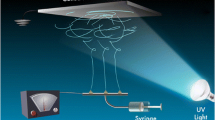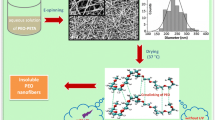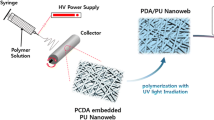Abstract
Nanofibers of polylactide (PLA)/poly(vinylpyrrolidone) (PVP) blends, loaded with TiO2 nanoparticles, have been prepared by an electrospinning method. The electrospun fiber mats were characterized by ATR-FTIR, X-ray diffraction (XRD), SEM, EDX, and UV-visible spectroscopy to examine structures, functional groups, crystallinity, surface morphology, and UV absorptivity. It is clearly observed that TiO2 particles are embedded on the filaments. All PLA-based spun fibers are completely amorphous in nature. The surface morphology of those blended with PVP is smoother and more uniform than the corresponding samples without PVP. Neat PLA fibers show a UV absorption band at around 200 nm, whereas the fibers loaded with TiO2 nanoparticles show an additional absorption band covering the 200–380-nm region. Photo-degradation of the fiber samples are conducted in phosphate buffer solution (PBS) under UVA light. The results indicate that the PVP component dissolves into the PBS solution, and the PLA matrix degrades as a function of time. The fibers are then applied as a catalytic system for epoxidation of unsaturated sunflower oil (SFO), for use as additives or plasticizers for biopolymers, employing a performic acid oxidizing agent. The fibers, especially those containing PVP, can effectively enhance the epoxidation yield of oils with a slow rate of undesirable side reactions, which break ester bonds of triglycerides to generate free fatty acids.













Similar content being viewed by others
References
Ali NA, Noori FTM (2014) Gas barrier properties of biodegradable polymer nanocomposites films. Chem Mater Res 6(1)
Ao CH, Lee SC, Mak CL, Chan LY (2003) Photodegradation of volatile organic compounds (VOCs) and NO for indoor air purification using TiO2: promotion versus inhibition effect of NO. Appl Catal B Environ 42(2):119–129. https://doi.org/10.1016/s0926-3373(02)00219-9
Benaniba MT, Belhaneche-Bensemra N, Gelbard G (2003) Stabilization of PVC by epoxidized sunflower oil in the presence of zinc and calcium stearates. Polym Degrad Stab 82(2):245–249. https://doi.org/10.1016/s0141-3910(03)00178-2
Bouchareb B, Benaniba MT (2008) Effects of epoxidized sunflower oil on the mechanical and dynamical analysis of the plasticized poly(vinyl chloride). J Appl Polym Sci 107(6):3442–3450. https://doi.org/10.1002/app.27458
Buzarovska A, Grozdanov A (2012) Biodegradable poly(L-lactic acid)/TiO2 nanocomposites: thermal properties and degradation. J Appl Polym Sci 123(4):2187–2193. https://doi.org/10.1002/app.34729
Buzarovska A, Gualandi C, Parrilli A, Scandola M (2015) Effect of TiO2 nanoparticle loading on poly(l-lactic acid) porous scaffolds fabricated by TIPS. Compos Part B 81:189–195. https://doi.org/10.1016/j.compositesb.2015.07.016
Chawengkijwanich C, Hayata Y (2008) Development of TiO2 powder-coated food packaging film and its ability to inactivate Escherichia coli in vitro and in actual tests. Int J Food Microbiol 123:288–292. https://doi.org/10.1016/j.ijfoodmicro.2007.12.017
Chua S-C, Xu X, Guo Z (2012) Emerging sustainable technology for epoxidation directed toward plant oil-based plasticizers. Process Biochem 47(10):1439–1451. https://doi.org/10.1016/j.procbio.2012.05.025
Devanand Venkatasubbu G, Ramasamy S, Ramakrishnan V, Kumar J (2013) Folate targeted PEGylated titanium dioxide nanoparticles as a nanocarrier for targeted paclitaxel drug delivery. Adv Powder Technol 24(6):947–954. https://doi.org/10.1016/j.apt.2013.01.008
Fischer K, Grimm M, Meyers J, Dietrich C, Gläser R, Schulze A (2015) Photoactive microfiltration membranes via directed synthesis of TiO2 nanoparticles on the polymer surface for removal of drugs from water. J Membr Sci 478:49–57. https://doi.org/10.1016/j.memsci.2015.01.009
Fukushima K, Abbate C, Tabuani D, Gennari M, Camino G (2009) Biodegradation of poly(lactic acid) and its nanocomposites. Polym Degrad Stab 94(10):1646–1655. https://doi.org/10.1016/j.polymdegradstab.2009.07.001
Gianotti E, Bisio C, Marchese L, Guidotti M, Ravasio N, Psaro R, Coluccia S (2007) Ti(IV) catalytic centers grafted on different siliceous materials: spectroscopic and catalytic study. J Phys Chem C 111(13):5083–5089. https://doi.org/10.1021/jp067506+
Guidotti M, Ravasio N, Psaro R, Gianotti E, Coluccia S, Marchese L (2006) Epoxidation of unsaturated FAMEs obtained from vegetable source over Ti(IV)-grafted silica catalysts: a comparison between ordered and non-ordered mesoporous materials. J Mol Catal A Chem 250(1–2):218–225. https://doi.org/10.1016/j.molcata.2006.01.032
Gupta KK, Mishra PK, Srivastava P, Gangwar M, Nath G, Maiti P (2013) Hydrothermal in situ preparation of TiO2 particles onto poly(lactic acid) electrospun nanofibres. Appl Surf Sci 264:375–382. https://doi.org/10.1016/j.apsusc.2012.10.029
Hong Y, Li Y, Zhuang X, Chen X, Jing X (2009) Electrospinning of multicomponent ultrathin fibrous nonwovens for semi-occlusive wound dressings. J Biomed Mater Res A 89A(2):345–354. https://doi.org/10.1002/jbm.a.31968
Kale G, Auras R, Singh SP, Narayan R (2007) Biodegradability of polylactide bottles in real and simulated composting conditions. Polym Test 26(8):1049–1061. https://doi.org/10.1016/j.polymertesting.2007.07.006
Kumar D, Ali A (2012) Ti/SiO2 as a nanosized solid catalyst for the epoxidation of fatty acid methyl esters and triglycerides. Energy Fuel 26(5):2953–2961. https://doi.org/10.1021/ef300127c
Lin W-C, Yang W-D, Jheng S-Y (2012) Photocatalytic degradation of dyes in water using porous nanocrystalline titanium dioxide. J Taiwan Inst Chem Eng 43:269–274. https://doi.org/10.1016/j.jtice.2011.10.010
Luo Y-B, Wang X-L, Wang Y-Z (2012) Effect of TiO2 nanoparticles on the long-term hydrolytic degradation behavior of PLA. Polym Degrad Stab 97(5):721–728. https://doi.org/10.1016/j.polymdegradstab.2012.02.011
Mekonnen T, Mussone P, Khalil H, Bressler D (2013) Progress in bio-based plastics and plasticizing modifications. J Mater Chem A 1(43):13379. https://doi.org/10.1039/c3ta12555f
Naghibi S, Hosseini HRM, Sani MAF, Shokrgozar MA, Mehrjoo M (2014) Mortality response of folate receptor-activated, PEG-functionalized TiO2 nanoparticles for doxorubicin loading with and without ultraviolet irradiation. Ceram Int 40:5481–5488. https://doi.org/10.1016/j.ceramint.2013.10.136
Nakayama N, Hayashi T (2007) Preparation and characterization of poly(l-lactic acid)/TiO2 nanoparticle nanocomposite films with high transparency and efficient photodegradability. Polym Degrad Stab 92(7):1255–1264. https://doi.org/10.1016/j.polymdegradstab.2007.03.026
Opaprakasit P, Opaprakasit M, Tangboriboonrat P (2007) Crystallization of polylactide and its stereocomplex investigated by two-dimensional Fourier transform infrared correlation spectroscopy employing carbonyl overtones. Appl Spectrosc 61(12):1352–1358
Pourali, A. R., & Ghanei, M. (2006). Efficient epoxidation of α,β-enones with polyvinylpyrrolidone supported hydrogen peroxide (PVP-H2O2). Bull Korean Chem Soc 27(10)
Rios L, Weckes P, Schuster H, Hoelderich W (2005) Mesoporous and amorphous Ti–silicas on the epoxidation of vegetable oils. J Catal 232(1):19–26. https://doi.org/10.1016/j.jcat.2005.02.011
Saithai P, Lecomte J, Dubreucq E, Tanrattanakul V (2013) Effects of different epoxidation methods of soybean oil on the characteristics of acrylated epoxidized soybean oil-co-poly(methyl methacrylate) copolymer. Express Polym Lett 7(11):910–924. https://doi.org/10.3144/expresspolymlett.2013.89
Sharifah Nafisah SI, Ahmad Faiza M, Rahmah M, Firdaus Y, Roslinda F, Dzaraini K (2013) Epoxidation of palm oil catalyzed by titanium-grafted silica catalyst. Adv Mater Res 812:30–37. https://doi.org/10.4028/www.scientific.net/AMR.812.30
Shimamoto GG, Favaro MMA, Tubino M (2015) Simple Methods via mid-IR or 1H NMR spectroscopy for the determination of the iodine value of vegetable oils. J Braz Chem Soc 26(7):1431–1437. https://doi.org/10.5935/0103-5053.20150111
Silva KIMD, Fernandes JA, Kohlrausch EC, Dupont J, Santos MJL, Gil MP (2014) Structural stability of photodegradable poly(l-lactic acid)/PE/TiO2 nanocomposites through TiO2 nanospheres and TiO2 nanotubes incorporation. Polym Bull 71(5):1205–1217. https://doi.org/10.1007/s00289-014-1119-0
Silvestre-Alberó J, Domine ME, Jordá JL, Navarro MT, Rey F, Rodríguez-Reinoso F, Corma A (2015) Spectroscopic, calorimetric, and catalytic evidences of hydrophobicity on Ti-MCM-41 silylated materials for olefin epoxidations. Appl Catal A Gen 507:14–25. https://doi.org/10.1016/j.apcata.2015.09.029
Sriromreun P, Petchsuk A, Opaprakasit M, Opaprakasit P (2013) Standard methods for characterizations of structure and hydrolytic degradation of aliphatic/aromatic copolyesters. Polym Degrad Stab 98(1):169–176. https://doi.org/10.1016/j.polymdegradstab.2012.10.014
Taghizadeh MT (2008) Stabilizing effect of epoxidized sunflower oil as a secondary stabilizer for Ca/Hg stabilized PVC. Express Polym Lett 2(1):65–76. https://doi.org/10.3144/expresspolymlett.2008.9
Tan SG, Chow WS (2010) Biobased epoxidized vegetable oils and its greener epoxy blends: a review. Polym-Plast Technol Eng 49(15):1581–1590. https://doi.org/10.1080/03602559.2010.512338
Wang T, Jiang H, Wan L, Zhao Q, Jiang T, Wang B, Wang S (2015) Potential application of functional porous TiO2 nanoparticles in light-controlled drug release and targeted drug delivery. Acta Biomater 13:354–363. https://doi.org/10.1016/j.actbio.2014.11.010
Xu J, Sun Y, Huang J, Chen C, Liu G, Jiang Y et al (2007) Photokilling cancer cells using highly cell-specific antibody-TiO2 bioconjugates and electroporation. Bioelectrochemistry 71(2):217–222. https://doi.org/10.1016/j.bioelechem.2007.06.001
Zakavi S, Abasi A, Pourali AR, & Rayati S (2008) Mn-porphyrin catalyzed epoxidation of alkenes with polyvinylpyrrolidone-supported H2O2. Bull. Korean Chem Soc 29(4)
Zhuang W, Liu J, Zhang JH, Hu BX, Shen J (2009) Preparation, characterization, and properties of TiO2/PLA nanocomposites by in situ polymerization. Polym Compos 30(8):1074–1080. https://doi.org/10.1002/pc.20658
Acknowledgements
The authors gratefully acknowledge the financial support from the National Research University (NRU) grant, provided by The Office of Higher Education Commission (OHEC) and the Center of Excellence in Materials and Plasma Technology (CoE M@P Tech), Thammasat University, Thailand. P.S. gratefully acknowledges financial support from Thammasat University Research Fund year 2554. B.N. thanks the support from the Excellent Foreign scholarship (EFS) program provided by SIIT.
Funding
This study was funded by the National Research University (NRU) grant, provided by The Office of Higher Education Commission (OHEC), Thammasat University Research Fund year 2554, and the Center of Excellence in Materials and Plasma Technology (CoE M@P Tech), Thammasat University, Thailand.
Author information
Authors and Affiliations
Corresponding author
Ethics declarations
Conflict of interest
The authors declare that they have no conflict of interest.
Electronic supplementary material
ESM 1
ATR-FTIR spectra of: (a) sunflower oil (SFO), (b) ESFO-1, (c) P-T-SFO-1, and (d) P-P-T-SFO-1, obtained from epoxidation reaction at 65 °C. (GIF 48 kb)
ESM 2
Curve fitting results from FTIR bands of olefinic bond and FFA liberation of (a)-(b) ESFO-1, (c)-(d) P-T-ESFO-1, and (e)-(f) P-P-T-ESFO-1, obtained from epoxidation reaction at 65 °C. (GIF 81 kb)
ESM 3
ATR-FTIR spectra of fiber catalyst before and after epoxidation process: (a) P-P-T15 fiber, (b) P-P-T-ESFO-0.5 (65 °C), (c) P-P-T-ESFO-0.5 (room temp.), and (d) P-T-ESFO-0.5 (room temp.). (GIF 56 kb)
Rights and permissions
About this article
Cite this article
Nim, B., Sreearunothai, P., Petchsuk, A. et al. Preparation of TiO2-loaded electrospun fibers of polylactide/poly(vinylpyrrolidone) blends for use as catalysts in epoxidation of unsaturated oils. J Nanopart Res 20, 100 (2018). https://doi.org/10.1007/s11051-018-4199-1
Received:
Accepted:
Published:
DOI: https://doi.org/10.1007/s11051-018-4199-1




